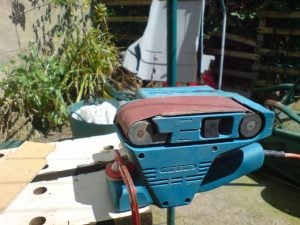[AdSense-A]A belt sander is one of my favorite power tools, not because of what it can do, but because of what it has done. They have easily become one of the most powerful power tools you can have in your shed, and for any woodworking enthusiast or the hobbyist at heart.
When looking at sanders, there is a wide array to choose from, and depending on what specifically you are needing to do choosing one over the other will be indicated. Belt sanders fit the bill of being able to shed a great deal of material quickly, and is typically used during the beginning phase of any sanding project.
Understanding how it works, and more importantly what it’s best suited for will help you get the most out of your  next project. Below, we have defined the top 5 uses of a belt sander and why you would need one.
next project. Below, we have defined the top 5 uses of a belt sander and why you would need one.
Refinish Wood
Sometimes all it takes is a couple of swipes with a sander and some stain to get rid of the old and replace it with the new. Refinishing wood items such as tables and chairs will help restore them to a newer look or create a new look all-together. If removing dark colored paint or stain, you’ll want to start out with a coarser grit such as 60 – 80 grit sandpaper. A couple of more swipes with medium grit paper such as 100 – 220 before finishing up with fine grit sandpaper.
Refinish Aluminum or Metal
Most people think of sanders as only sanding wood, but with a belt sander this is far from the truth. Metals and other materials such as aluminum can be sanded using a stationary sander. The belt and sandpaper makes it a great option as the sandpaper itself tends to open up unlike other types of sanders such. This reduces the chance of clogging which is problematic with sanders with grinding wheels.
Check Out the Top 7 Belt Sanders
Fixing Interior or Exterior Doors to Help Them Close Easily
We’ve all encountered a door that just doesn’t open or close right. Typically, it’s caused by the door rubbing against the door frame. No matter how many times we realign the hinges or tighten them up, the door seems to always stick. More times than not, sanding off a 1/8th of an inch will usually do the trick, and with a belt sander it will take no time at all.
If You Need Something Sanded Now
One of the most noticeable differences between a belt sander and other types is the amount of time you actually use it. Due to the aggressive nature, belt sanders remove a lot of material in a very short amount of time.
Sharpening Tools Such as Chisels
Probably the most unconventional use of a belt sander is to use it to sharpen other tools. I have found that old chisels that I’m getting ready to throw away can be sort of refurbished and reshaped easily using a stationary belt sander. While I wouldn’t recommend doing this with any of your top of the line tools, but it’s a great way to re-sharpen tools that don’t require a perfectly straight edge.
Smooth and Round Edges and Corners
Although a belt sander isn’t the best type to smooth and round edges and corners, it can be done with ease. The versatility of a belt sander makes it very easy to maneuver with two hands while rounding edges and corners. This is a great tool if you are looking for an approximate and quick rather than precise and much slower.
[AdSense-A]





